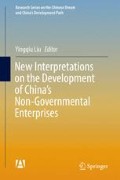Abstract
A non-governmental economy is essentially one in which economic activities and investments are made, benefits are enjoyed, and risks are taken by the citizens; or, in more common language, it refers to the economic activities that involve private investment, private benefits, and private risk-taking. Strictly speaking, such an economy should be better named a “civilian economy” or “private sector of the economy”.
Access this chapter
Tax calculation will be finalised at checkout
Purchases are for personal use only
Notes
- 1.
See Address of Mao Zedong at the Closing Ceremony of 2nd Session of 1st CPPCC, June 23, 1950. In Mao Zedong. (1999). Works of Mao Zedong. Beijing: People’s Publishing House, p. 80.
- 2.
Article 31 of the Common Program stipulates, “Enterprises jointly operated by state and private capital are enterprises of a state-capitalist character. When necessary and possible, private capital should be encouraged to develop into national capitalism, e.g., processing for the SOEs, jointly operating with the state, operating SOEs on loan, developing the state resources, and so forth.” By then, it had not been recognized that national capitalism is a path towards the transformation of private-owned capitalist industry and commerce.
- 3.
On Sept. 7, 1953, Mao Zedong invited and had a talk with Chen Shutong and nine other people outside the Party at the Hall of Health and Longevity. According to the talk, “Four Horses Dividing Fruits” means that in the profit allocation of national capitalist enterprises (namely, enterprises of joint state-private management), the income tax accounted for 34.5%, the welfare fund for 15%, the reserve fund for 30%, and the capitalists’ dividend for the rest, or 20.5%..
- 4.
At the General Assembly of the All China Federation of Industry & Commerce (ACFIC) on Oct. 11, 1953, many people recognized that “socialism is an irresistible trend everyone should follow.” Some proposed to “actively run their business, endeavor to play their roles, keep away from the five evils, receive the restrictions, reinforce learning, and welcome the transformation.” See Pang Xianzhi, & Jin Chongji. (2003). Biography of Mao Zedong (1949–1976), (1st ed.). Beijing: Central Committee Documents Publishing House, p. 435.
- 5.
In 1954, the government adopted the “apple-biting” or the one-by-one model, and realized the joint state-private management of 793 industrial enterprises, all of which were relatively large and concerned the national interest and people’s livelihood. Their output of that year was valued at RMB 2.56 billion, more than the totaled output of all the jointly-managed enterprises in the previous several years. See Pang Xianzhi, & Jin Chongji. (2003). Biography of Mao Zedong (1949–1976), (1st ed.). Beijing: Central Committee Documents Publishing House, p. 437.
- 6.
Towards the bourgeoisie, it was pointed out in the Resolution of the Central Committee of the Communist Party of China on the Transformation of Capitalist Industry and Commerce that, firstly, we should change the capitalist ownership by ways of buyout and state capitalism gradually rather than abruptly, with compensation rather than without compensation; secondly, we should arrange their work as necessary while conducting the transformation, and; third, we should not disfranchise them of the right to vote, but must make appropriate political arrangements for the representatives of those who have vigorously supported and contributed to the socialist transformation.
- 7.
Estimation methods to be found in Li Zinai, & Ye Azhong. (2000). Advanced Econometrics. Beijing: Tsinghua University Press, pp. 40–42.
Bibliography
Atkeson A, Kehoe P (1997) Industry evolution and transition: a neoclassical benchmark, NBER working paper, 6005. NBER, Cambridge, MA
Chen R, Zhang Q, Zhou M. Report on export of Zhejiang’s NGEs. http://www.zj.xinhuanet.com/. Accessed 29 Sept 2007
Jiang L (2006) Eight contributions of China’s NGEs. J Cent Inst Soc (8)
Jovanovic B (1995) Learning and growth, NBER working paper, 5383. NBER, Cambridge, MA
Liu G (1988) Models of China’s economic system reform. China Social Sciences Press, Beijing
Liu X (2003) Long-term growth of China’s economy. Econ Res J (5)
Research Group of Non-Governmental Investment Mechanism and Development of Shaanxi’s NGEs (2006) Evaluation of NGEs’ contributions to economic developemnt of Shaanxi. West Econ Dev Res (3)
Shao G, Zhang R (2004) Evaluation of NGEs’ contributions to development of Guangdong. Stat Decis (12)
Sheng H (1994) Transitional economics of China. Shanghai People’s Press, Shanghai, China
Song Y, Yang Y, Dong M (2004) Development and growth of NGEs. Rev Econ Res (22)
Wu J (2004) Economists, economics and China’s reform. Econ Res J (2)
Xue M (1990) On China’s reform of the economic system. Tianjin People’s Press, Tianjin, China
Yang Q (2004) Has China’s economic reform improved enterprise performance? A DEA evaluation of China’s large and medium enterprises, Working paper, no. 287. ESRC Centre for Business Research, University of Cambridge
Zhao Z (2007) Contributions of China’s NGEs to industrial structure adjustment. Mark Mod (6)
Zheng X (2005) Contributions of Shanghai’s NGEs to GDP of Shanghai and relevancy analysis. Shanghai Bus (2)
Author information
Authors and Affiliations
Editor information
Editors and Affiliations
Rights and permissions
Copyright information
© 2017 Social Sciences Academic Press and Springer Nature Singapore Pte Ltd.
About this chapter
Cite this chapter
Liu, X. (2017). The Post-WTO Era: NGEs’ New Development and the Sustained Rapid Growth of China’s Economy. In: Liu, Y. (eds) New Interpretations on the Development of China’s Non-Governmental Enterprises . Research Series on the Chinese Dream and China’s Development Path. Springer, Singapore. https://doi.org/10.1007/978-981-10-3872-3_2
Download citation
DOI: https://doi.org/10.1007/978-981-10-3872-3_2
Published:
Publisher Name: Springer, Singapore
Print ISBN: 978-981-10-3870-9
Online ISBN: 978-981-10-3872-3
eBook Packages: Economics and FinanceEconomics and Finance (R0)

